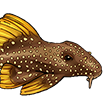/siluriformes/loricariidae/scobinancistrus/aureatus/1.jpg) Adult
Adult/siluriformes/loricariidae/scobinancistrus/aureatus/2.jpg)
/siluriformes/loricariidae/scobinancistrus/aureatus/3.jpg)
/siluriformes/loricariidae/scobinancistrus/aureatus/4.jpg) Adult (Rio Xingu in background)
Adult (Rio Xingu in background)/siluriformes/loricariidae/scobinancistrus/aureatus/5.jpg)
 Video - juvenile
Video - juvenile/siluriformes/loricariidae/scobinancistrus/aureatus/7.jpg)
/siluriformes/loricariidae/scobinancistrus/aureatus/8.jpg) Adult
Adult/siluriformes/loricariidae/scobinancistrus/aureatus/9.jpg)
/siluriformes/loricariidae/scobinancistrus/aureatus/10.jpg)
/siluriformes/loricariidae/scobinancistrus/aureatus/11.jpg)
/siluriformes/loricariidae/scobinancistrus/aureatus/12.jpg) Close-up of head
Close-up of head/siluriformes/loricariidae/scobinancistrus/aureatus/13.jpg) 68mm SL
68mm SL/siluriformes/loricariidae/scobinancistrus/aureatus/14.jpg) Dorsal view of head
Dorsal view of head/siluriformes/loricariidae/scobinancistrus/aureatus/15.jpg) Ventral view
Ventral view/siluriformes/loricariidae/scobinancistrus/aureatus/16.jpg) Close-up of teeth
Close-up of teeth/siluriformes/loricariidae/scobinancistrus/aureatus/17.jpg)
/siluriformes/loricariidae/scobinancistrus/aureatus/18.jpg) Close-up of mouth
Close-up of mouth/siluriformes/loricariidae/scobinancistrus/aureatus/19.jpg) Male
Male/siluriformes/loricariidae/scobinancistrus/aureatus/20.jpg) Female
Female/siluriformes/loricariidae/scobinancistrus/aureatus/21.jpg) Three day old eggs
Three day old eggs/siluriformes/loricariidae/scobinancistrus/aureatus/22.jpg) Four day old eggs
Four day old eggs/siluriformes/loricariidae/scobinancistrus/aureatus/23.jpg) Five day old eggs
Five day old eggs/siluriformes/loricariidae/scobinancistrus/aureatus/24.jpg) Six day old fry
Six day old fry/siluriformes/loricariidae/scobinancistrus/aureatus/25.jpg) Eight day old fry
Eight day old fry/siluriformes/loricariidae/scobinancistrus/aureatus/26.jpg) Ten day old fry
Ten day old fry/siluriformes/loricariidae/scobinancistrus/aureatus/27.jpg) Twelve day old fry
Twelve day old fry/siluriformes/loricariidae/scobinancistrus/aureatus/28.jpg) Forty five day old juveniles
Forty five day old juveniles/siluriformes/loricariidae/scobinancistrus/aureatus/29.jpg) Ninety day old juveniles
Ninety day old juveniles/siluriformes/loricariidae/scobinancistrus/aureatus/30.jpg) Five month old juvenile
Five month old juvenile/siluriformes/loricariidae/scobinancistrus/aureatus/31.jpg) Ten month old juveniles
Ten month old juveniles/siluriformes/loricariidae/scobinancistrus/aureatus/32.jpg) Juveniles are territorial
Juveniles are territorial/siluriformes/loricariidae/scobinancistrus/aureatus/33.jpg) Head of male
Head of male/siluriformes/loricariidae/scobinancistrus/aureatus/34.jpg) Head of female
Head of female/siluriformes/loricariidae/scobinancistrus/aureatus/35.jpg) Body of male showing odontodes
Body of male showing odontodes/siluriformes/loricariidae/scobinancistrus/aureatus/36.jpg) Female body showing absence of odontodes
Female body showing absence of odontodes/siluriformes/loricariidae/scobinancistrus/aureatus/37.jpg) Close-up of eye
Close-up of eye/siluriformes/loricariidae/scobinancistrus/aureatus/38.jpg) Close-up of opercular odontodes
Close-up of opercular odontodes/siluriformes/loricariidae/scobinancistrus/aureatus/39.jpg)
/siluriformes/loricariidae/scobinancistrus/aureatus/40.jpg) Three day old fry
Three day old fry/siluriformes/loricariidae/scobinancistrus/aureatus/41.jpg) Eggs approx. 6 hours after being laid
Eggs approx. 6 hours after being laid/siluriformes/loricariidae/scobinancistrus/aureatus/42.jpg) Eggs five days being laid, a day before hatching
Eggs five days being laid, a day before hatching/siluriformes/loricariidae/scobinancistrus/aureatus/43.jpg) Close-up of pectoral fin
Close-up of pectoral fin/siluriformes/loricariidae/scobinancistrus/aureatus/44.jpg) Close-up of dorsal fin
Close-up of dorsal fin/siluriformes/loricariidae/scobinancistrus/aureatus/45.jpg) Close-up of caudal fin
Close-up of caudal fin
| Scientific Name | Scobinancistrus aureatus Burgess, 1994 |
| Common Names | L014, Sunshine Pleco Goldie Pleco, Solskinssugemalle (Denmark) |
| Type Locality | Ilha da Fazenda, Rio Xingú, Estado Pará, Brazil. |
| Synonym(s) | Panaque aureatus |
| Pronunciation | aw RE at us |
| Etymology | (Latin)Scobis=Sawdust + (Greek)agkistron=hook. aureatus = golden; alluding to the golden finnage. |
| Articles | |
| Size | 250mm or 9.8" SL. Find near, nearer or same sized spp. |
| Identification | Striking sub-adult colouration which diminishes in adults which are still quite distinctive. Commonly known as the Goldie or Sunshine pleco, this ultimately larger fish is a frequent import. |
| Sexing | Males grow larger than females. Males develop a more ''bristled'' appearance that, in certain light, can shine from the light being reflected off the fish. The leading edge of the leading pectoral fin ray also becomes slightly spiny in mature males. Head shape, when view from above is blockier in males and more triangular in females. Females are wider across the midriff. |
| Distribution | South America: Xingu River basin, Brazil. Amazon, Lower Amazon, Xingu (click on these areas to find other species found there) Login to view the map. |
| IUCN Red List Category | Vulnerable , range map and more is available on the IUCN species page. Last assessed 2018. |
| pH | 5.8 - 7.2 |
| Temperature | 25.0-29.0°C or 77-84.2°F (Show species within this range) |
| Other Parameters | Clean, clear, highly oxygenated, preferably with a noticeable current although this is not vital. |
| Feeding | Sinking pellets and frozen bloodworm are ideal although all prepared foods that reach the bottom are accepted. Larger individuals will tackle whole king prawns and mussels with relish. Will eat garden snails and the first breeder of this genus feed their fishes meat and veg in the form of pumpkin. An omnivore that will eat most things and shares with the wood-eating plecos the unusual habit of eating the skin of vegetables before the flesh. User data. |
| Furniture | Sandy or small pea-shaped gravel with groups of rounded stones and few or no plants best reproduces this fishes natural habitat. If keeping with similarly sized plecos, arrange the aquarium to ensure there are plenty of hiding places and multiple feeding areas to diffuse feeding time ''focus''. |
| Compatibility | A robust pleco suited for most environments, the only catch being the heat. |
| Suggested Tankmates | Suitable as a discus or angelfish tank pleco. Also OK with South American cichlids - a good way to brighten up any oscar tank - but might not do well with Central American cichlids due to their slightly lower temperature requirements. Perfect with rainbowfish if you don't mind breaking the biotope mould. |
| Breeding | Has been bred in captivity. |
| Breeding Reports | There is no breeding report. |
| Reference | Tropical Fish Hobbyist v. 43 (no. 1), pp 237, Figs. 1-6 (unnumbered). |
| Registered Keepers | There are 261 registered keepers, view all "my cats" data. |
| Wishlists | Love this species? Click the heart to add it to your wish list. There are 25 wishes to keep this species, see who wants what. |
| Spotters | Spotted this species somewhere? Click the binoculars! There are 73 records of this fish being seen, view them all. |
| Forum BBCode | |
| Search for S. aureatus | |
| Look up S. aureatus on AquaticRepublic.com | |
 | Look up S. aureatus on Fishbase |
 | Look up S. aureatus on Encyclopedia of Life |
 | Look up S. aureatus on Global Biodiversity Information Facility |
| LFS label creator ARN ref:1.4.73.161 | |
| Last Update | 2025 Jan 01 12:09 (species record created: 2001 Apr 29 00:00) |




